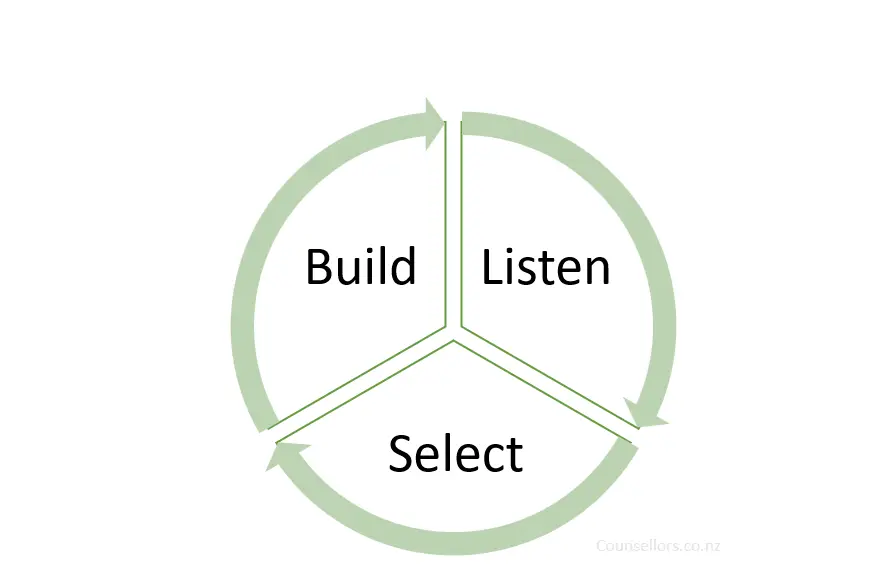Solution-focused brief therapy – SFBT is an approach inspired by Steve de Shazer and Insoo Berg in the 1970s. This goal orientated approach emphasizes the client’s present and desirable future rather than their past experiences. De Shazer and Berg created this modality to change the trend of dwelling on the problems but instead spend more time in the present to work on a desirable future with their clients. They find that their clients are less inclined to explore future possibilities when they are too focused on their problems.
The role of the counsellor or the therapist is to listen, select and build. Clients are experts of their circumstances. They have the solutions and need the space and time to examine their existing toolbox. SFBT tools consist of strategic and gentle questions to help draw out the solutions that the client had used in the past. Clients can make use of the therapy time to examine the answers and work collaboratively with the counsellor or therapist to construct a better future so that there is a relief to their problems.

SFBT is suitable for personal and also group therapy. Sessions can be conducted face-to-face or online via Zoom. For people that prefer to work on solutions and do not want to wait, SFBT via online counselling can be helpful.
Solution-Focused Brief Intervention Tools
1. Change the language. Language plays a big part in our thought processes. Asking the right positive question can help the client to transcend into positivity. For example, asking a mother: “What does your son say about your anger?” would invoke a negative response as they start to recall all the angry moments. “What does your son say when you are
happy with him?” It will help the client bring forth the good moments to examine and construct desirable behaviours.
2. Goal setting through collaboration and negotiation.
Setting goals gives purpose to the therapeutic process of SFBT. SMART and GROW models help facilitate the goal-setting process.
SMART – Specific, Measurable, Achievable, Realistic and Timely.
GROW- Goal-orientated, Reality, Options and Will or Way Forward.
SFBT is most effective when the goals are measurable to ensure an end in sight for all the effort the client put in to find the solutions.
3. Use Miracle questions. Miracles or the magic wand questions help invoke the client to think about a future where their problem did not exist. Inviting the client to use their imagination to describe what that day would look like can lead to an outline of a possible outcome. An overview of that vision is a good way for the counsellor to work with the client to
gradually build the desirable future through a series of realistic, clear, concrete steps.
4. Ask about the exceptions. Problems do not happen the same way all the time. There will be instances where the client would have handled it differently. Clients may want more tools and may not know what they already possess. Finding exceptions is a valuable way to help reinforce the client’s ability to solve their problem and how to utilize those solutions for future issues.
5. Scaling questions. Scaling questions can help clients examine the severity of their current problems. It is the most vital tool in SFBT for its usefulness in encouraging clients to self-assess. Numbers are a handy medium to help clients determine their current uncomfortableness level. It is also helpful to help the client assess their motivation towards a goal
they have set and how much dedication they can apply to achieve their goals.
Solution-Focused Brief Therapy Tenets

Solution-focused brief therapy uses a pragmatic perspective to help clients gain clarity on the goals they wish to achieve. The following tenets make up the foundation of the SFBT intervention model:
Prioritize the client’s desired outcome and goals—one of the most vital tenets of SFBT. Focus on the client’s desired outcome. Dwelling on past problems will not likely help them achieve their current goal.
Explore the exceptions to the problems. There will be times when issues are not likely to occur. Looking for exceptions in those circumstances can help the client find the solutions they may already know of to conceptualize a solution for the current problem.
Ask instead of directing. Using exploratory questions can help the client figure out how they can think or feel more or less about the problems in their life. Asking questions brings more structure for the client as they tell their story of who they are and where they would like to be. Using clients’ knowledge of their behavioural patterns is a way to help them envision the possible changes they can make to act and feel differently for the better.
Bring the future to the present. The past is not changeable, but we can work on the times ahead. The here and now is the best time to work with clients on their goals. It is more productive and motivating for the client to focus on finding solutions for the desirable future than looking back.
Validation through compliments. Compliments tell the client that we care. It encourages the clients to keep doing the excellent work that they are already doing and reinforces their positive behaviours. It also encourages them to share more about the changes they notice when they know they are valued.
Change is the only constant. Nothing stays the same. Minor changes are not always noticeable, but they are
there. Highlight the small changes that are occurring. Frequent small changes will likely be more apparent in the times ahead.
Solutions may not relate to the problem. Logically, there is always a solution to a problem. In reality, we do not live in a black-or-white world. In Solution-focused brief therapy, solutions are drawn from client’s experience. Taking a fresh look at some of the solutions clients has used in the past may help the present issue.
Solution-Focused Brief Therapy application in current mental health issues
Solution-focused brief therapy can be helpful for people that want to talk more about finding solutions than dwell on the problems that they currently have. The therapy structure allows the client to work on one issue at a time to achieve the change and seeing the small changes through the process. Below is a list of concerns that works well with SFBT:
· Depression
· Anxiety
· Self-esteem
· Relationship issues and work-related stress.
· Substance abuse/ Addiction
· Parenting issues.
Limitations to Solution-Focused Brief Therapy
1. Solution-focused brief therapy format may result in missing the underlying issues.
2. There is no time to build an empathetic relationship to cater to the client’s emotional distress.
3. Solution-focused brief therapy process may get in the way of the client’s emotional journey if they bring up a problem outside the client’s ability to change.
All of the above are good points aiming at the issues of trying to fix a problem. Solution-focused brief therapy shares the same values that clients are experts in their own experiences and seeks to provide a safe place to see more positivity in their actions.
Therapists and counsellors can use a variety of modalities, including SFBT, to help clients find relief, even if it is brief, to help them cope in this modern world. They may return with other problems, and that is ok. Problems can arise,
and there is always a way to address the issue. It may or may not be the same solution, but finding a solution together is better than doing it ourselves.
